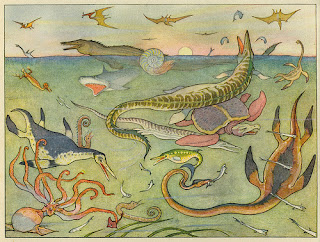The book is a kind of pictorial introduction to the prehistoric world, but it is what the prehistoric world looked like in 1944. The way people in the past thought about their own past is a source of endless fascination, just as much as the way they imagined the future. I think that somebody could probably write a Guided History of Past Imaginings of Dinosaurs if they wanted to: a chronicle of how dinosaurs have been conceptualised and re-conceptualised with each generation.
The art in the book is just completely delightful - and I don't use that word lightly. The illustrator and author, E. Boyd Smith, doesn't even appear to have a Wikipedia entry, but take a look at these pictures and tell me they don't delight you.
Just look at the face on that Tyrannosaur. He seems full of trepidation almost, as though compelled into violence which he does not really seek. The dinosaurs and other prehistoric beasts in the book are so anthropomorphized they are practically people. Everything about their eyes, faces and gestures is so incredibly expressive - even the dimetrodon in the first picture seems almost sad and desperate as he chases after his prey.
What kind of a world was the Boyd-Smithian prehistoric earth? A world thronging with sentient, thinking, feeling, creatures, almost more human than humans. A world of vivid colours and dream-like hallucinogenic vistas. A world that is almost friendly - yet one in which predation is everywhere and nobody can rest for a moment without having to find a way to defend themselves. It's like a world where everything is dialed to 11: everything in it lives with its heart on its sleeve, by turns euphoric, terrified, aggressive and playful.
This dream-dinosaur world is more fantasy than science, as we now know, but I love the idea of it and the vividness of its vision. I want to make a campaign setting there - or, more specifically, a campaign setting on an old pulp vision of a "wet Venus" covered in jungle and volcanoes and inhabited by these uber-emotional beasts. The fertile, fecund, feminine counterpoint to barren warlike authoritarian masculine Mars, as it was imagined, funnily enough, in the 1930s and 1940s - the era of E. Boyd Smith himself.









The art is amazing! I love his style, and the colors are excellent, and evocative. Great find!
ReplyDeleteWhat a find! My spirits are lifted just knowing somebody somewhere in the world discovered this flawless gem of a book among their belongings. This is what a treasure is. Delightful!
ReplyDeleteOh, and even more delightful, which I didn't notice until I looked through the images close up, is the young lad with his dignified, doubtless scientist/inventor grandfather and his black cat who pop up in the images as witnesses to these prehistoric melodramas.
ReplyDeleteIf I were a dragon I would hoard books, and I enjoin you in all seriousness: keep this one well, noisms. It is precious.
Yeah, there is an accompanying story about Dr Peter and his nephew Bobby.
DeleteI looked it up on eBay and there is a copy going for £168. I won't sell it but I think it may be the only book in my possession with genuine value.
That is a gorgeous book, I'm envious. Glad BJ Johnson pointed out the 20th century visitors - is there a storyline relating to them? Also, one thing I noticed was the rat-like 'early mammals' in some of the dinosaur pics. I remember these from my own dinosaur books as a kid; they almost seem like a way of saying 'look! these are our ancestors, scurrying about...'
ReplyDeleteYes, see above. It's about a kid called Bobby whose uncle introduces him to the wonders of prehistory. It's very charming.
DeleteReminds me of this a whole lot:
ReplyDeletehttps://boardgamegeek.com/boardgameexpansion/152045/vor-maelstrom-growlers/images
Yes, I know what you mean. Something to do with fecundity.
DeleteThat, and the colourful mania.
DeleteWhat a wonderful, imaginative book. On your point about past imaginings/reinventions of dinosaurs, you might check out the blog https://chasmosaurs.blogspot.com/. The author loves to go through vintage images of dinosaurs from books, museums, advertisements, etc., and it is surprising how many there are!
ReplyDeleteGreat blog, thanks!
DeleteReally enjoyed your post! I love how crowded each illustration is with these wonderful creatures!
ReplyDelete